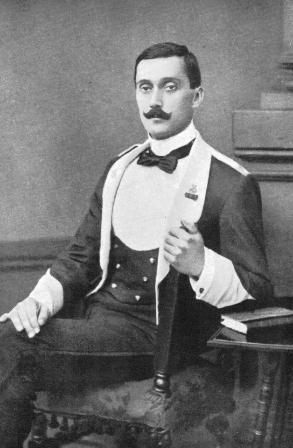07 January 1916
HELLES - On 7 January, with the Turks deeply suspicious as to what the British were up to at Helles. Liman finally decided to test the waters by ordering an attack along Gully Spur.
 Photograph of Lieutenant-Colonel Frank Walker, 7th North Staffordshire Regiment, 39th Brigade, 13th Division
Photograph of Lieutenant-Colonel Frank Walker, 7th North Staffordshire Regiment, 39th Brigade, 13th Division
"During the first days of January 1916 it appeared as though the fire of the land artillery at Sedd el Bahr was becoming weaker. But one gun was firing from several batteries, frequently changing its position, while the fire from the ships, including the largest calibres, sometimes grew to great vehemence. The removal of guns was observed from the Asiatic side. The scouting parties which were pushed forward against the hostile front at all hours of evening and night, invariably met with strong resistance. Of the troops designated for the attack, the 12th Division had arrived in rear of the south front. The division was designated to capture a section of trenches projecting northward opposite the extreme Turkish right, from which the British artillery could have flanked the great attack we were planning. On January 7th I ordered the 12th Division to carry out the attack planned on the extreme Turkish right after 2 hours of preparation by the heaviest artillery fire and explosion of mines." (General Otto Liman von Sanders, Headquarters Fifth Army, Turkish Army).
The shells rained down from about noon. Ordinary Seaman Joe Murray recalled the unexpected ferocity of the shelling.
"The Turks began an intensive bombardment of both sides of the Gully Ravine. It was soon obvious that this was the prelude to an attack. The question was - "How long did we have to wait?" As the hours passed, thousands of shells crashed into the empty support trenches and those that fell in the front line took their toll. It was by far the most severe and prolonged shelling I have ever experienced."
The shelling built up to a final crescendo, before the Turks went over the top following the explosion of two mines on Gully Spur at 16.00 on 7 January. Murray was alongside the 7th North Staffords in the front line when they attacked.
"The Turks charged over, shouting wildly. They had about a hundred yards to cover before reaching my particular part of the line though they had less ground to cover a little further to the left. After their four and a half hours' warning, we were ready for them.... They came in their hundreds, some carrying timber for use in bridging our trenches. Perhaps they thought that after these hours of shelling there would be no one to stop them, but they had not reckoned with the Staffords of the 13th Division and eight sappers who could handle rifles as well as the rest. We should be able to - we have had plenty of practice. We blazed away at the advancing Turks who did not now appear to be in such a hurry to get to the coast. Some were becoming hesitant when our warships helped them to make up their minds. I thought the Navy had deserted us long ago and it was very heartening to hear their salvoes. We certainly needed their help."(Ordinary Seaman Joe Murray, Hood Battalion, 2nd Brigade, RND).
In the end the attack was in reality a damp squib for the Turkish infantry seemed to lack their usual élan and those that did emerge from their trenches were soon quashed by a combination of small arms fire and the naval support fire tearing into the Turkish flank. A few did manage to enter the North Staffords lines in the Fifth Avenue sector. Afterwards the Adjutant, Captain John Robinson, wrote to the wife of his commanding officer, Lieutenant-Colonel Frank Walker to tell her what happened to her husband.
"During all the bombardment your husband was in the firing line. Then the Turks attacked. Their trenches were, at one corner only, from 10-15 yards away. Some four Turks got onto the parapet of our trench here and Colonel Walker finding the bay empty collected three or four and rushed into the bay, into which the Turks were firing. I believe he shot two with his revolver and was himself shot. But the Turks were driven off. That I think is the plain unvarnished tale. He fell down into the bottom of the trench and two of our men fell dead on the top of him. I feel sure he did not speak and that he felt no pain." (Captain John Robinson, 7th North Staffordshire Regiment, 39th Brigade, 13th Division).
Colonel Frank Walker was buried in Border Ravine close to his dugout, in a grave marked out with empty shell cases and a solid wooden cross edged in black and recording his name. Despite the efforts of his men the location of the grave was lost and he is now commemorated on the Helles Memorial.
The British were enormously relieved that this attack had not been pushed home. That day their total numbers at Helles stood at only 19,000 with some 63 guns in support. Any sustained effort by the Turks would have surely broken through. Everyone feared a renewed assault and the tension remained excruciating. That night another 2,300 men and 9 guns were evacuated. Still the Turks seemed oblivious as to what was going on.
SOURCE:
O. L. von Sanders, "Five Years in Turkey", (Nashville, Tennessee: The Battery Press, 2000), p.101-102, J. Murray, "Gallipoli - As I Saw It", (London, Kimber, 1963), p218, IWM DOCS: F. Y. Robinson quoted in manuscript letter by N. Walker in T. A. Andrus Collection, 14/2/1916
